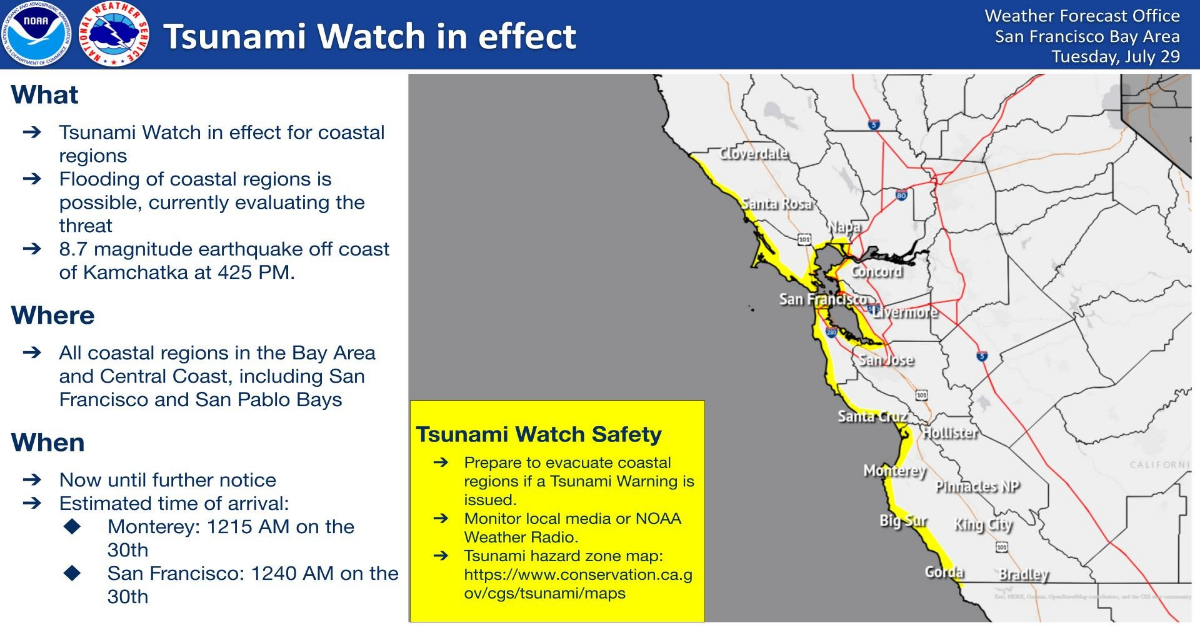A tsunami watch was issued for the California coast on July 29, 2025 after a large earthquake off Russia.
National Weather Service/Handout
A tsunami advisory has been issued for the entire California coast after a powerful earthquake struck across the Pacific Ocean on Tuesday.
Japan’s meteorological agency said the quake hit near Russia’s Kamchatka Peninsula at 8:25 a.m. (2325 GMT Tuesday) and registered a preliminary magnitude of 8.0. It issued an advisory for a tsunami of up to 1 meter along the Pacific coast of Japan. So far no damage has been reported. The quake was about 250 kilometers away from Hokkaido, Japan’s northernmost of the country’s four big islands, and was felt only slightly, according to Japan’s NHK television.
Article continues below this ad
The U.S. Geological Survey said it hit at a depth of 12 miles. The USGC said shortly after initial reports that the quake’s strength was 8.8 magnitude.
The National Tsunami Warning Center, based in Alaska, issued a tsunami warning for parts of the Alaska Aleutian Islands, and an advisory for the West Coast, including California, Oregon and Washington. The advisory also includes a vast swath of Alaska’s coast line, including parts of the panhandle.
The National Weather Service’s Bay Area office said the estimated time of arrival in California is approximately 11:50 p.m. in Fort Bragg, 12:15 a.m. in Monterey, 12:40 a.m. in San Francisco and 1:05 a.m. at Los Angeles harbor. “Flooding of coastal regions is possible,” although meteorologists are still “currently evaluating the threat,” the NWS said in its alert. Updates can be found on the National Tsunami Warning Center’s site, and tsunami maps can be found via the California Department of Conservation. No evacuation orders have been issued in California.
People should avoid the shore and stay out of the ocean until further notice, as “dangerous currents and waves are possible,” the weather service said. “If you are located in this coastal area, move off the beach and out of harbors and marinas,” the weather service said in the advisory. “Do not go to the coast to watch the tsunami. Be alert to instructions from your local emergency officials.”
Article continues below this ad
Meteorologists also warned that a tsunami can “arrive as a series of waves or surges which could be dangerous for many hours after the first wave arrival. The first tsunami wave or surge may not be the highest in the series.” In the Bay Area, the weather service is currently forecasting peak tsunami wave heights at less than 1 foot. The surge could last anywhere from 10 to 36 hours, forecasters said.
In Hawaii, a tsunami warning has been issued for the state. Residents are being asked to evacuate on parts of the islands; evacuation information can be found via Oahu Emergency Management. The first expected waves are anticipated at 7:17 p.m. HST. Maui County officials warn the waves “could cause damage along coastlines of all islands in the state of Hawaii.”
Russia’s Tass news agency reported from the biggest city nearby, Petropavlovsk-Kamchatsky, that many people ran out into the street without shoes or outerwear. Cabinets toppled inside homes, mirrors were broken, cars swayed in the street and balconies on buildings shook noticeably. Tass also reported power outages and mobile phone service failures in the capital of the Kamchatka region.
Article continues below this ad
According to Japan’s tsunami advisory, which is a lower-level warning than a tsunami alert, a first wave of tsunami was expected in eastern Hokkaido around an hour and half after the quake. The government said it set up a taskforce for information gathering and response in case of any emergency. A University of Tokyo seismologist Shinichi Sakai told NHK that a distant earthquake could cause a tsunami that affects Japan if its epicenter is shallow.
The Associated Press contributed to this report.
